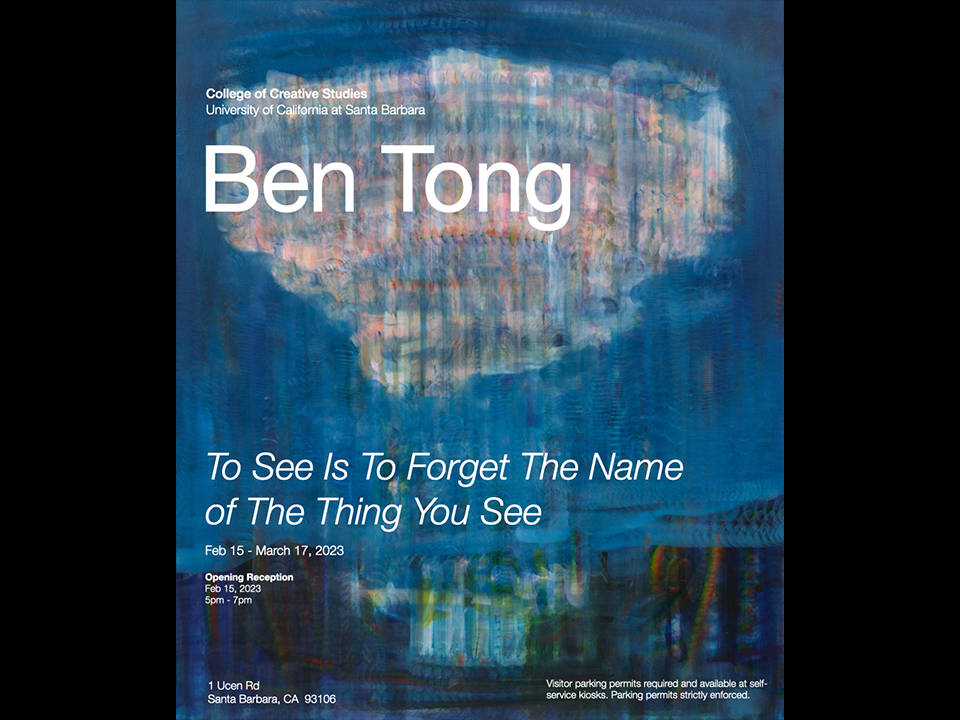
Ben Tong Art Exhibition (2/15 - 3/17)
UC Santa Barbara's College of Creative Studies (CCS) will host an exhibition, “To See Is To Forget The Name Of The Thing You See,” by artist Ben Tong and curated by Kim Córdova '07 (CCS Art). The exhibit will open with a reception on February 15 from 5:00 - 7:00 pm in the CCS Gallery. The show will be on display through March 17.
Visitor information
The College of Creative Studies is located at: 1 UCEN Rd, Santa Barbara, CA
Parking: On the weekends and after 5 pm during the week, parking lot 3 is recommended. During business hours, parking structure 18 is recommended. Permits are required to park on campus and strictly enforced. Permits are available in self-service kiosks located at each lot. For more information on visitor parking, please see the UCSB Transportation and Parking Services website.
Gallery hours are Mon-Fri 12-5 pm or by appointment. To arrange after-hours viewing or for accessibility accommodations contact CCS Gallery Director Dan Connally at dconnally@ucsb.edu.
Press release from exhibition curator, Kim Córdova:
Ben Tong
“To See Is To Forget The Name Of The Thing You See”
College of Creative Studies
University of California at Santa Barbara
February 15-March 17, 2023
Gallery hours Mon-Fri 12-5 pm or by appointment.
Painting and the experience of light and time as embodied knowledge operate as both subject and object in painter Ben Tong’s dynamic works. In To See Is to Forget the Name of the Thing You See, at CCS at UCSB, Tong presents a new series of paintings that are the result of his focus on a pursuit of light including the metaphorical and metaphysical diffractions which illuminate physical and conceptual worlds.
That California light, perhaps more than any other quality, cuts to the core of the state’s being. Whether a milky honey haze, electric vanilla, or piercing knife-blade blue, the arresting quality of the sun in the land of manifest destiny both suspends time and runs through it forming for residents and visitors a crystalline lineage of perception. Northern, southern, and central coasts are each steeped in their own specific chiaroscuros of western pacific shimmer. For Hollywood directors, aerospace engineers, artists, occultists, and utopian dreamers, the light in the west continues to beckon those seeking enlightening. Referencing both the quote attributed to poet Paul Valéry, “to see is to forget the name of the thing one sees” and the Lawrence Wechsler monograph on Robert Irwin’s work, Seeing is Forgetting the Name of the Thing One Sees, this presentation traverses the relationship between space and Californian light by following its undulations through its relationship with the region’s other signature atmospheric condition: the haze. Like a protean scrim of billions of microscopic worlds, the locally monikered “marine layer” gives weight and form to the sun’s waves of radiation washing over Earth’s shore. Like the materiality of paint, which becomes subject and object as waves of light pass through it, atmospheric hazes protagonize light as object of fascination with aerosolized particles that bounce, scatter, bend, and gild it.
Representations of light in painting have for centuries has been used as metaphor to refer to consciousness. But rather than represent consciousness, Tong’s intuitive practice rides it as a wave or frequency that constructs realities. In his work he follows light as it reverberates off the canvas ground, bending as it travels through translucent layers of paint which our brains interpret as color and form. For Tong, this makes painting nothing less than a connection between the experience on earth to the stuff of the cosmos: the overwhelmingly improbable yet spectacularly fortunate relationship between the frequencies of light emitted from the belly of our solar system, the time it takes these waves to arrive at a canvas and bounce off the ground, and the existence of the viewer who witnesses them. Some compositions suggest dual relationships: interiors and exteriors, domestic and public, darkness and light, diffuse and diffracted light. Tiny moments signal possibilities for expanded meaning. Repeated circular forms like tracking the phases of painted moons call to mind the shadows of heavenly bodies cast by pinhole cameras and eclipse viewers registering meaning-imbued movements of the cosmos on earth. Triangular shapes in Dog’s Ears reminiscent of the terror of shadows on the bedroom wall, or Plato’s cave, suggest how realities are fabrications of light, perception, and time. They call to mind futurist Buckminster Fuller’s 1969 lectures at The College of Creative Studies in which he pronounced “The Universe is an aggregate of non-simultaneous and only partially overlapping time events.”
Image Credits: Ben Tong, Lenticular Cloud and Reservoir, oil on canvas, 66” x 56” 2022
Images courtesy of: the artist, Night Gallery, and The College of Creative Studies.
Photos by Nik Massey.
IG: @ucsb_ccs @Tongbean @ThisisKimCo
FB: www.facebook.com/collegeofcreativestudies
Twitter: @UCSB_CCS